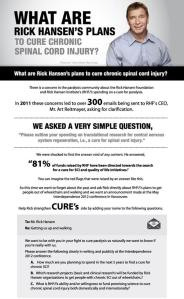Unite 2 Fight Paralysis uses the tagline, “Voice of the Cure”. What does the word “cure” mean to us? Our vision of a cure includes:
- Restoration of one’s fully functional and healthy body, including relief from pain and spasms, return of bowel, bladder and sexual function, and recovery of normal sensation in addition to motor control. Once cured a person should be able to live independently, free of assistive devices, caregivers, catheters, etc.
- Belief that curative therapies will come in stages, and support for advancing research into each stage as it becomes more promising.
- Understanding that recovery will come through combinations of therapies that may vary just as much as the nature of spinal cord injuries. To this end we promote and support collaborations amongst scientists, investors, advocates, clinicians, and regulatory agencies.
- Commitment over the long term to successive stages of recovery, refusing to be satisfied until all bodily functions are restored.
 We fight for those who have lost the most, and for whom regeneration is the only pathway back to a healthy body and productive life. Let us never forget about those with complete injuries and little or no return, those who have no family support and are shuffled off to nursing homes, those on ventilators who require 24/7 assistance, those who do not have the time and/or money to spend the hours necessary to maximize recovery.
We fight for those who have lost the most, and for whom regeneration is the only pathway back to a healthy body and productive life. Let us never forget about those with complete injuries and little or no return, those who have no family support and are shuffled off to nursing homes, those on ventilators who require 24/7 assistance, those who do not have the time and/or money to spend the hours necessary to maximize recovery.
We don’t want to start a “pity party”, but we do want to increase awareness of these realities. Decision-makers need to understand that paralysis is a progressive and burdensome condition, that research science shows great promise and needs financial support, that restoring function will save millions of dollars for SCI survivors, their families, and society.




You must be logged in to post a comment.